|
The History of the Akita Dog
Odate-inu
After the National isolation policy
during the 300-year Tokugawa Period was brought to an end in 1853, many
different types of dogs were imported from countries throughout the world
together with foreign cultures.
The rapid
acceptance of Western culture during the Meiji Period (1868-1912), led to a
decreasing interest in Japanese culture in Japan and thus to a reduction or
extinction of many Japanese objects and living creatures during this period.
People also began to favour Western dogs and this led to the neglect of Japanese
dogs. The general tendency was to value things Western, and foreign dog breeds
were highly esteemed. As a result, the indigenous Japanese dogs were gradually
being out crossed and the situation became serious in the later years of the
Taisho Period (1912—1926). Soon fewer Japanese dogs were seen in the cities, and
were confined to remote hunting villages in the mountains.
Many different
dogs were used in this cross-breeding. This included a very large dog with
hanging ears thought to be a Mastiff. This dog was brought to the Akita area
around 1868 by a German mining engineer who had been invited to the Ani Copper
Mine. Another one was a very large dog, thought to be a St. Bernard of mixed
breeding. He was purchased overseas around 1904 by Mr. Kenkichi Mogami of
Kakumagawa machi in Southern Akita.
|
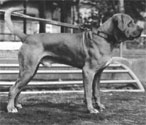 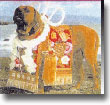
Tosa |
Tosa fighting
dogs were now introduced in the Akita Prefecture. At first, the Akita breed was
stronger than the Tosa. Gradually, the situation reversed because of
cross-breeding of with the Tosa breed end European breeds. However, the
organizers and fans of dogfights in Odate encountered a sudden blow. Dogfights,
bullfights and cockfights had all become very popular in many areas of Japan and
the money bet was so enormous that strict government controls were enacted
everywhere. In 1909, Masataka Mon, the governor of Akita Prefecture at that
time, enacted an ordinance to prohibit dog fighting altogether.
Dogfight
devotees in Odate now lost the purpose for keeping their dogs. To make matters
worse, the following year a law for taxation of dogs also was enacted. This,
combined with a movement for the extermination of feral dogs, which was
triggered by an outbreak of rabies, resulted in a terrible setback for the
Odate-inu and put them on the verge of extinction.
Crossbreeding
was further intensified to produce dogs of a still different type that were
called “Kairyo-ken” (“Improved Dog”) or “Shin-Akita” (“New Akita”). The main
difference between these dogs and the Tosa was tail set. The ideal tail carriage
for an “Improved Dog” was a tail curled over the back. These new varieties were
promoted and praised until the beginning of the Showa era (late 20’s). From the
Meiji to the Taisho era, Odate dogs were therefore classified into two
categories. One was the Japanese type, which was over average height, with erect
ears and a curled tail. The other type was the mixed European type,
“Shin-Akita”, used in dog fights.
|
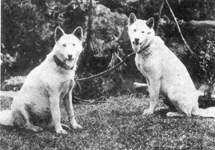
Odate-inu, 1910 |
|
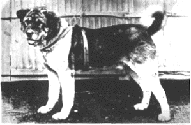
Odate dogs, “Shin-Akitas”,
around 1910 |
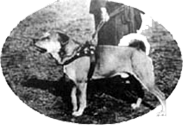
(Shin Akita photos
by S. Mahar, knl Awoyama, USA) |
It almost
seemed as though pure Japanese dogs were no longer to be found around Odate. The
truth of the matter is that regional dogs were kept in villages near Odate as
guard dogs as well as in the mountains as hunting dogs, Matagi-inus.
The Akita dog,
however, decreased the most amongst the Japanese dogs, not only in numbers, but
also in purity due to the crossbreeding with western dogs and the Tosa.
Around 1915,
concerned Japanese intellectuals among the dog fanciers, led by the Mayor of
Odate, began a movement to halt the crossbreeding trend, and preserve certain
Japanese cultural assets for future generations, including Japanese dogs. Much
due to this work the Japanese Government was influenced into establishing “The
Natural Monument Legislation” in 1919, and under the leadership of Dr.
Shozaburo Watase the legislation for the preservation of species was passed.
This has greatly mattered in preserve the pure blood of Japanese dogs today.
|
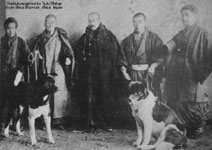
Emperor Taisho’s two Odate-inu’s in 1899
(Photo by S. Mahar, knl Awoyama, USA) |
In 1899, two Odate-inu were presented to Emperor Taisho while he still was a
crown prince.
Also, two Odate-inu were shown at the Taisho Exposition in 1914 in Ueno, Tokyo.
They gained honours by receiving silver and bronze prizes.
|

1919
(Photo
by S. Mahar, knl Awoyama, USA) |
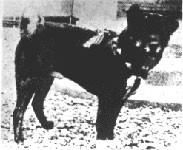
1920 |
In 1920, Dr. Watase came to the Odate area to survey Odate dogs. However, since
there were so many different types of Akita dogs, he was unable to designate any
as natural monuments.
Dr. Watase’s survey to test the eligibility of Odate-inus as Natural Monuments
by a national law, took the fanciers in Odate by surprise. They suddenly
recognized the importance of preserving the purebred Japanese Dog. This is what
ultimately paved the way for the restoration of the Akita, which was the first
breed to be designated as a “Natural Monument”.
The designation
of the breed as a Natural Monument was thus the most effective means of
preventing excessive crossbreeding. The fanciers and the public now became aware
of the importance of the preserving the native Japanese breeds.
In order to
restore the breed, representatives were sent into the rural area and Matagi
villages to purchase regional dogs as these were considered to be less affected
by mixed breeding.
|
 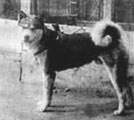
1930
(Photo by S. Mahar, knl Awoyama, USA) |
Natural Monument
Although the natural monument legislation was established by the Japanese
government in 1919, almost twelve years passed before the Akita dog was declared
as a Natural Monument in July 1931, after a visit by a second survey team led by
Dr. Tokio Kaburagi to Odate, with a stipulation that the Akita dog be restored
toward what one believes to be the pure Japanese dog type. Japanese dogs at that
time were known only by their regional names. In Akita, large dogs were called
the Odate dog, Nambu dog, Kazuno dog, etc. The name Akita inu,
representing all the large dogs in Odate, was now used for the first time upon
it’s legislation in September 1931 and 9 superior Akita dogs were designated as
Natural Monuments.
|

1927 |

1935 |
According to
many of the Japanese dog scholars, including Mr. Yonekichi Hiraiwa of Tokyo and
Professor Katsushiro Kudo of the Iwate University, the original pure type of
Akita dog was probably the size of Matagi dogs found in the remote mountain
villages throughout Japan. Those Matagi dogs were slightly larger than the
medium dogs.
Hachiko
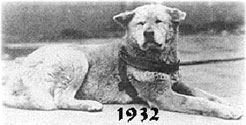
The
faithfulness of Hachiko
was reported in the Asahi newspaper of August 4, 1932, and the reputation of
Akitas became well known all over Japan. Hachiko was born in Odate in 1923 and
came to Tokyo two months later. Hachiko's owner was Dr. Ueno, a professor at the
Tokyo University. Dr. Ueno passed away when Hachiko was only a year and a half
old. For the next ten years, Hachiko continued to go to Shibuya station every
evening to wait for his master even though his master had died. Hachiko himself
died in 1935.
Hachiko’s story touched the hearts of, not only the fanciers, but also the
Japanese people as a whole. The name “Hachiko” became known throughout the
country and the breed, the Akita, also shared the limelight.The public interest
in Hachiko popularized the name “Akita” and caught the attention of fanciers.
However, no further development of the breed could be expected at this time
because of the Manchurian Incident (1931) and the subsequent 15 years of war.
This is probably the reason why published material and records about Akitas
around this time are limited to the tales about Hachiko.
The
Wars
Soon,
the Manchurian Incident
in the 1930’s which in turn led to the expanded war into the cold northern areas
of China, forced the use of dogs and cats as sources of fur for military coats.
Because of their size, Akita’s were in big demand and were intently sought out.
The police ordered the confiscation and capture of all dogs other than German
Shepherds used for military purposes. Dogcatchers were said to search deeply
into narrow alleys in towns and villages to capture and kill them. Fanciers
tried to escape the order and took their dogs to Matagis and farmers in the
mountains, or to apple orchards in Aomori Prefecture to be used as guard dogs.
Some tried to confuse the catchers by naming their Akitas with names typically
used for German Shepherds, or by crossbreeding with them. This explains why
names such as “Peace”, “Long”, “Carl” and “Mary” were given to the sires and
dams of postwar Akitas. In any case, this was an extremely unfortunate period
for dogs as well as for their owners and admirers.
After the war
between Japan and China, half of Karafuto (Sakhalin) was transferred to Japan.
Many Japanese from the northeast part of Japan went there to work as herring
fishermen and in similar occupations. Accordingly, big dogs from Karafuto (56-66
cm at the withers and weighing 30-40 kg) moved into the northeast part of Japan
(Hokkaido) together with their owners upon their return and were naturally bred
to indigenous dogs, which is the reason why the Akita breed experiences
long-coats time and again.
|
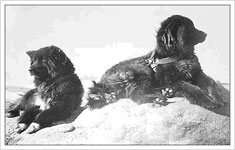
Karafuto-inu |
In September
1941 Japan began participating in the World War II. Because of food shortage,
this was a difficult period to raise large dogs such as the Akita dog and anyone
seen feeding dogs often to be branded as traitors. Therefore, many Akita dogs
were destroyed at that time since they were quite noticeable. Most dogs in Japan
were also conscripted for military use. However, a few people secretly kept the
Akita. Also, during the severe food and clothing shortages during the immediate
postwar period, some dogs became sources for hides and meat.
Helen
Keller
Helen
Keller is renowned
as a person who successfully challenged the disabilities of being blind, deaf
and mute. She visited Japan in 1937, including the Akita Prefecture on her tour.
It was at this time that she expressed her desire to own an Akita as a pet,
having heard about Hachiko. Mr.Ichiro Ogasawara presented her with an Akita,
named Kamikaze, to Ms. Keller. This was the first time an Akita entered the US.
Unfortunately, the dog died of distemper. Kamikaze's brother, Kenzan, was sent
as a replacement to the US by ship in 1939.
It is said that Helen Keller's impression of the Akita breed was "with the
exception of the Akita, there is no dog that understands his master's feeling."
However, the news of Miss Helen Keller's and other American's interests in Akita
dog led to a great popularity of Akita dog, so that, according to rumours, even
the mongrel types of Akita dogs were sold at high prices. The timing was also
perfect for Kongo-go which won top honors at the JKC's shows at this
time. Also the same type of dog, Kincho-go, won the Meiyosho Award at the
Akiho show, resulting in the rapid increase in that type of Akita dog from the
late 1940s to the mid 1950s. However, some fanciers became quite alarmed at this
trend and started a move to further improve the breed which resulted in Akita
dogs of today. |














